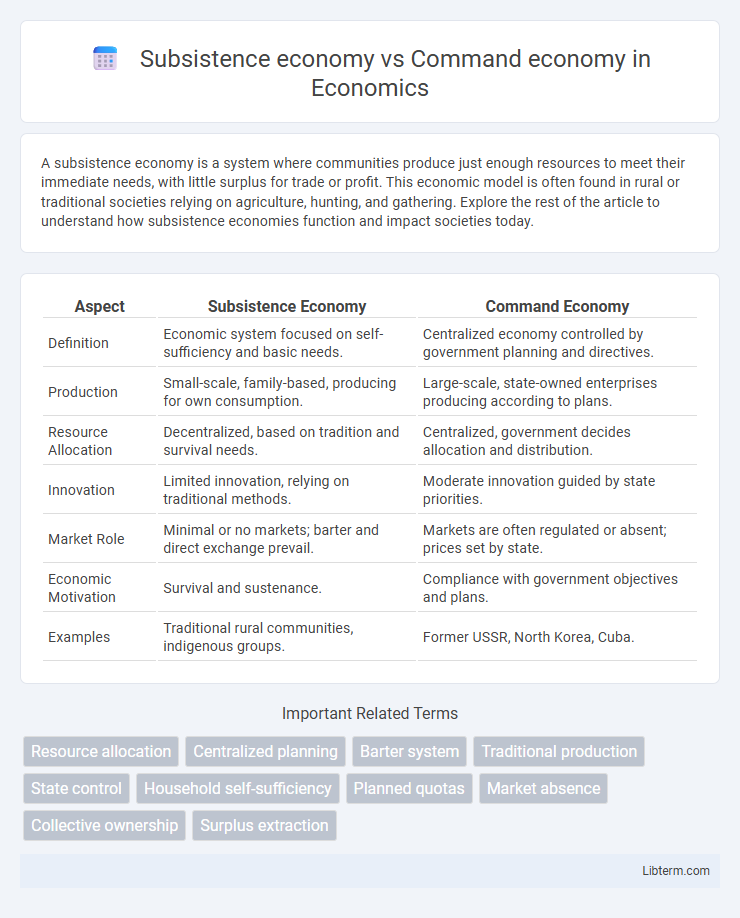A subsistence economy is a system where communities produce just enough resources to meet their immediate needs, with little surplus for trade or profit. This economic model is often found in rural or traditional societies relying on agriculture, hunting, and gathering. Explore the rest of the article to understand how subsistence economies function and impact societies today.
Table of Comparison
| Aspect | Subsistence Economy | Command Economy |
|---|---|---|
| Definition | Economic system focused on self-sufficiency and basic needs. | Centralized economy controlled by government planning and directives. |
| Production | Small-scale, family-based, producing for own consumption. | Large-scale, state-owned enterprises producing according to plans. |
| Resource Allocation | Decentralized, based on tradition and survival needs. | Centralized, government decides allocation and distribution. |
| Innovation | Limited innovation, relying on traditional methods. | Moderate innovation guided by state priorities. |
| Market Role | Minimal or no markets; barter and direct exchange prevail. | Markets are often regulated or absent; prices set by state. |
| Economic Motivation | Survival and sustenance. | Compliance with government objectives and plans. |
| Examples | Traditional rural communities, indigenous groups. | Former USSR, North Korea, Cuba. |
Introduction to Economic Systems
A subsistence economy primarily relies on self-sufficiency, where communities produce just enough goods to meet their needs with limited surplus or trade. In contrast, a command economy features centralized government control over production, distribution, and resource allocation, directing economic activities according to planned objectives. Understanding these economic systems highlights fundamental differences in decision-making, resource management, and societal goals within various economic frameworks.
Definition of Subsistence Economy
A subsistence economy is an economic system where communities rely primarily on natural resources to produce goods for their own consumption rather than for trade or profit. It typically involves small-scale agriculture, hunting, and gathering, with little surplus or specialization. This contrasts with a command economy, where the government centrally plans and controls production, distribution, and resource allocation.
Definition of Command Economy
A command economy is an economic system where the government centrally plans and controls production, distribution, and prices of goods and services. Unlike a subsistence economy, which relies on individual or community self-sufficiency for basic needs, a command economy allocates resources based on collective goals rather than market demand. This centralized control aims to eliminate economic inequality and ensure equitable access to resources across society.
Key Characteristics of Subsistence Economies
Subsistence economies primarily rely on agriculture and natural resource use for direct consumption rather than market exchange, emphasizing self-sufficiency and minimal surplus production. These economies typically feature simple technology and traditional methods passed through generations, with limited specialization of labor and minimal integration into global trade systems. The key characteristic is the focus on meeting immediate needs of the community, with production and distribution organized around familial or tribal groups.
Key Characteristics of Command Economies
Command economies are characterized by centralized government control over production, distribution, and pricing of goods and services, eliminating market-driven decision-making. The government sets economic goals, allocates resources, and controls labor employment to achieve planned outputs. This system contrasts with subsistence economies where individuals or communities primarily produce for their own consumption rather than for exchange or profit.
Resource Allocation in Subsistence vs Command Economies
Subsistence economies allocate resources primarily based on immediate household or community needs, relying on traditional methods and bartering systems rather than market forces. In command economies, resource allocation is centrally planned and controlled by the government, which determines production quotas and distribution to meet national economic goals. This centralized control often leads to inefficiencies and shortages, contrasting with the localized, need-based distribution characteristic of subsistence economies.
Advantages and Disadvantages of Subsistence Economies
Subsistence economies primarily rely on self-sufficient agriculture and hunting, offering advantages such as low dependence on external markets and preservation of cultural traditions. However, they face significant disadvantages including limited economic growth, low productivity, and vulnerability to environmental changes. The lack of surplus production restricts trade opportunities and technological advancements, hindering overall development.
Advantages and Disadvantages of Command Economies
Command economies centralize resource allocation and production decisions under government control, enabling rapid mobilization of resources and consistent provision of basic goods. This system can achieve large-scale projects and social welfare goals efficiently but often suffers from lack of consumer choice, inefficiencies due to bureaucratic planning, and reduced incentives for innovation. Command economies may also experience shortages or surpluses when government planning fails to accurately match supply with demand.
Real-World Examples and Case Studies
Subsistence economies, such as those in rural parts of Sub-Saharan Africa and the Amazon Basin, rely heavily on self-sufficient farming and local resource use with minimal market interaction. Command economies, exemplified by North Korea and historically by the Soviet Union, feature centralized government control over production, distribution, and pricing, often resulting in resource allocation inefficiencies. Case studies from Cuba's transition to a mixed economy illustrate challenges in shifting from strict command systems toward more market-oriented reforms to improve economic performance.
Conclusion: Comparing Subsistence and Command Economies
Subsistence economies rely on self-sufficiency, producing primarily for local consumption with minimal surplus or trade, while command economies emphasize centralized control and planned production to meet national objectives. Subsistence models often lack scalability and innovation due to resource limitations, whereas command economies can mobilize resources for large-scale projects but may suffer from inefficiencies and shortages. The fundamental difference lies in decentralized survival-based activity versus centrally planned allocation, affecting economic growth, resource distribution, and societal development.
Subsistence economy Infographic

 libterm.com
libterm.com